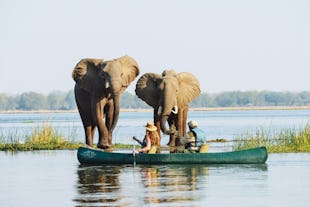
7 active safari ideas
Keep your heart rate high



The Kalahari may be a desert, but what a desert it is. The seemingly never-ending plains (50,000 square kilometres to be exact) dominate central Botswana and are part of the largest continuous sand basin on earth. Established as a sanctuary for the San bushmen in 1961, the reserve was, until very recently, closed to the public and even today only very few make it to this wild and untouched expanse of pristine land. But those who do embark on a Kalahari safari can look forward to remarkable sightings of the powerful black-maned lions of Deception Valley, interactions with fascinating San tribesmen and the most phenomenal stargazing on the planet.
Start with a recommended trip or create one from scratch
If there’s one word to sum up the Central Kalahari, it would be remote. Adventurous, wild and untrammelled, most come here for the experience of simply being and take in the magic of the unknown, desert landscape. Wildlife is not abundant, but sightings are very special and morning, afternoon and night game drives are available at all times of year. Sightings include magnificent Kalahari black-maned lion, cheetah, and desert-adapted antelope like oryx and springbok. In the green season (November to March) quantities of wildlife increase as animals gather at the sources of water. When the sun goes down, there’s a good chance of seeing honey badgers, brown hyena and servals. Alternatively, head out on foot and enjoy the intimate details of the desert, sometimes missed from a vehicle. The other side to the Kalahari is the chance to absorb the culture of the San. One of the oldest peoples on earth, their traditions are complex and fascinating. Join the tribe on a walk, hunting, seeking out medicinal plants and tracking wildlife, or visit the village and take part in daily life.
The Central Kalahari is the perfect antidote to the modern world. Think mind-bogglingly vast landscapes, views that reveal the curvature of the earth, and pure, unaltered, unaffected space.
Penetrate the hidden corners of the stunning area on a mobile safari, camping under the smatterings of acacia trees and chasing the slivers of shade. With an expert guide and local tracker by your side, it’s an experience like no other.
The desert is best experienced when it’s most difficult to get to, in the first months of the year. It’s at this time that the summer rains arrive, bringing with them sweet grasses, hungry herbivores and even hungrier predators.
Jan
Feb
Mar
Apr
May
Jun
Jul
Aug
Sep
Oct
Nov
Dec
Wet Season
Day and night temperatures are high with moderate humidity, rainfall is at its peak for this desert environment.
January welcomes in the birth of the next generation towards the end of the month.
A time of high activity amongst the predators as they take full advantage of the walking buffet.
Vegetation is green, wild flowers are in bloom and birds are in their breeding plumage.
Wet Season
Day and night temperatures are high with moderate humidity, rainfall is at its peak for this desert environment.
The perfect time to view the newborns, as they find their wobbly feet.
A time of high activity amongst the predators as they take full advantage of the naive newborns.
Vegetation is green, wild flowers are in bloom and birds are in their breeding plumage.
During the green season there are more insects and mosquitoes around, luring out a host of unique insectivores.
Wet Season
There is low humidity with high temperatures, rainfall begins to drop with shorter periods of bad weather.
The ideal time to visit the Central Kalahari, plenty of game to view with high predator activities.
Wildlife is in pristine condition, migratory birds are present and enjoying the lush green vegetation.
Unique desert flowering species, barking gecko's and the chirping rain locusts make an unusual but fascinating change to the more traditional safari.
During the green season there are more insects and mosquitoes around, luring out a host of unique insectivores.
Wet Season
Temperatures are still high in April, with rain taking the form of irregular afternoon showers.
The end of the wet season has arrived, as long as there is grazing and water available, wildlife will remain in the area.
Vegetation dries and thins, providing the perfect conditions and opportunities to view the area's wildlife.
Clarity improves for photography, showcasing the breath-taking landscapes of this wonderfully different wilderness.
Dry Season
May is a transition month, temperatures begin to drop from the extremes and rain is almost nonexistent.
Water sources begin to dry, animal densities drop but there are still interesting encounters with the unique resident species.
Great time to enjoy the bushman experience, with an arid landscape, clear blue skies and moderate temperatures.
Clarity improves for photography, showcasing the breath-taking landscapes of this true wilderness.
Dry Season
Temperatures are comfortable but have dropped considerably at night, with morning frost on occasion, rainfall dry's up.
The animals are spread out over large areas, but this is a good month to view the many unique desert species not often seen elsewhere in Botswana.
Great time to enjoy the bushman experience with clear blue skies and moderate temperatures.
The air is thin and still, creating the perfect time to photograph the unique local species, as well as the inspiring landscapes.
The night sky is at its most impressive, with shooting stars and the Milky Way taking centre stage.
Dont forget to pack a warm jacket for this time of year.
Dry Season
Nights are cold with occasional frost, day temperatures are comfortable and rainfall dry's up.
The animals are spread out over large areas, but this is a good month to view the many unique desert species not often seen elsewhere in Botswana.
Great time to enjoy the bushman experience with clear blue skies and moderate temperatures.
The air is thin and still, creating the perfect time to photograph the unique local species, as well as the inspiring landscapes.
The night sky is at its most impressive, with shooting stars and the Milky Way taking centre stage.
Pack a warm jacket for the chilly early mornings and night time.
Dry Season
The coldest night temperatures have passed, with the daylight hours warming considerably, rain is still very unlikely.
The animals are spread out over large areas, but this is a good month to view the many unique desert species not often seen elsewhere in Botswana.
There are very few insects and mosquitoes around during this time of year.
The air is thin and still, creating the perfect time to photograph the unique local species, as well as the inspiring landscapes.
The night sky is at its most impressive, with shooting stars and the Milky Way taking centre stage.
Don't forget to pack a warm jacket for this time of year.
Dry Season
Temperatures start to climb, with rain being unlikely in the month of September.
The animals are spread out over large areas, but this is a good month to view the many unique desert species not often seen elsewhere in Botswana.
There are very few insects and mosquitoes around during this time of year.
The air is thin and still, creating the perfect time to photograph the unique local species, as well as the inspiring landscapes.
The night sky is at its most impressive, with shooting stars and the Milky Way taking centre stage.
Pack a warm jacket for the chilly early mornings and night time.
Dry Season
Temperatures reach their peak with humidity starting to climb towards the end of the month, it is unlikely that the rains will fall in October over the Kalahari.
The dry landscape will burst into life should the first rains arrive, animals move back into the area as it becomes more hospitable.
Wildlife is in need of rain after the dry season, spread over large distances, survival is an everyday struggle.
An interesting month for photography, there is high humidity, with the landscape at its most extreme before the arrival of the first rains.
Wet Season
Temperatures are hot and relatively humid with the first rains of the year falling in the form of afternoon showers.
This can be difficult to predict as weather can come early or late depending on the year.
This is the start of the 'green season' with wildlife migrating back into the game reserve to feed on the newly shooting grasses.
Insects become more prevalent at this time of year but remain lower than other parts of Botswana.
Known for interesting cloud formations and spectacular electrical storms illuminate the nights sky.
Wet Season
Temperatures are hot and relatively humid with rain falling in the form of afternoon showers.
This is the start of the 'green season' with wildlife migrating back into the game reserve to feed on the newly shooting grasses.
Migratory birds have returned, creating a hive of activity as they display for the opposite sex.
Insects become more prevalent at this time of year but remain lower than other parts of Botswana.
Known for interesting cloud formations and spectacular electrical storms illuminate the nights sky.